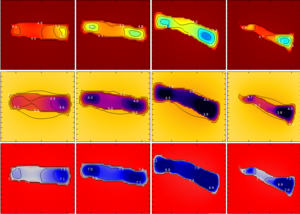
OVERVIEW
This study aims to guide the selection of patients who make good candidates for stem cell therapy to treat backpain. Over 70% of people suffer from back pain at some point in their lifetime costing the U.S. economy up to $100 billion annually. The model in this study predicts, with high precision, nutrient availability for injected stem cells by modeling glucose, oxygen, and pH gradients in the intervertebral disc. Ultimately, the model allows physicians to personalize stem cell therapy to meet the unique nutrient demand in the patient’s disc and thus increases the success rate of the therapy.
BACKGROUND
Backpain has a great impact on the socioeconomic status of many workers around the world. In the U.S. alone, backpain is responsible for loss of over 100 million workdays every year. Backpain can be attributed to degeneration of the intervertebral disc allowing nerve ingrowth, joint arthritis, and herniation. Recently, animal and human studies have shown promising potential for stem cell injections to restore disc health and alleviate backpain compared to current invasive therapies, e.g. spinal fusion. However, success of stem cell therapy has been reported to be as low as 40% in patients. Researchers believe that changes in disc nutrient distribution as the disc degenerates is a main cause for the death of injected cells leading to therapy failure. Therefore, being able to predict nutrient distribution in the disc is important in developing cell-based treatments to regenerate the disc.
IMPORTANCE OF THE MODEL
Several modeling methods have been developed to study nutrient availability in the intervertebral disc, but this is the first model to use imaging techniques to create specific disc nutrient distributions. This model, which has a different methodology compared to other models in the literature, extracts the actual geometry of the disc and its transport properties from MRI scans then computes personalized distribution maps for glucose, oxygen, and pH in the disc.
RESULTS
- Average nutrient concentration in the disc decreases as the disc severely degenerates by 15.2% for glucose, and 13.6% for dissolved oxygen.
- A 10% increase in lactate is associated with a decrease in the minimum concentration of glucose and dissolved oxygen in the disc by 11.9% and 4.8%, respectively.
- Each patient has a unique nutrient distribution pattern in which patients with abnormal disc geometry exhibit abnormal nutrient concentrations
- Discs with high average nutrient concentration can have localized regions with very poor nutrient concentrations
MODEL FUTURE WORK
Although the model’s predictions of nutrient concentration in the intervertebral disc agree with what is reported in the literature, there are three ways in which the model’s accuracy and precision can be improved:
- Incorporating the composition of the disc’s extracellular matrix, which affects molecular transport, increases the model’s accuracy in predicting nutrient concentration
- Adding the third dimension in the model allows to better estimate the disc’s nutrient holding capacity, and thus improve the model’s predictions
- Validating the model’s predictions on human discs will demonstrate the model’s applicability in clinical settings to select patients for stem cell therapy
MEDICAL APPLICATIONS
Developing a model that can predict nutrient availability in the intervertebral disc of backpain patients can advance disc regeneration treatments in three different ways:
- Personalizing injected cell density to meet the unique nutrient demands in each patient’s disc will guarantee higher survival rates of such cells
- Selecting patients who have discs with optimal geometry and diffusion properties will guarantee an improved success of stem cell therapy
- Substituting animal models to test the effects of various drugs and treatments on disc regeneration will provide more accurate outcomes and decrease research cost
